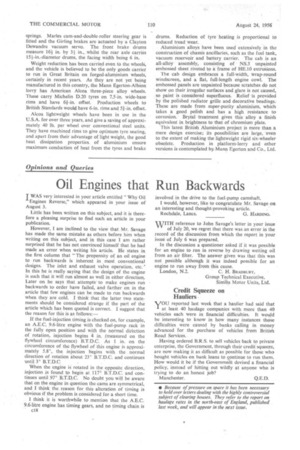Opinions and Queries
Page 56

If you've noticed an error in this article please click here to report it so we can fix it.
Oil Engines that Run Backwards
T WAS very interested in your article entitled "Why Oil 'Engines Reverse," which appeared in your issue of August 3.
Little has been written on this subject, and it is therefore a pleasing surprise to find such an article in your publication.
However, I am inclined to the view that Mr. Savage has made the same mistake as others before him when writing on this subject, and in this case I am rather surprised that he has not convinced himself that he had made an error when writing his article. He states in the first column that "The propensity of an oil engine to run backwards is inherent in . most conventional designs. The inlet and exhaust valve operation, etc:' In this he is really saying that the design of the engine is such that it will run almost as well in either direction. Later on he says that attempts to make engines run backwards to order have failed, and farther on in the article that few engines can be made to run backwards when they are cold. I think that the latter two statements should be considered strange if the part of the article which has been quoted is correct. I suggest that the reason for this is as follows:— If the fuel-injection timing is checked on, for example, an A.E.C. 9.6-litre engine with the fuel-pump rack in the fully open position and with the normal direction of rotation, injection begins 4 in. (measured on the flywheel circumference) B.T.D.C. As 1 in. on the circumference of the flywheel of this engine is approximately 5.8°, the injection begins with the normal direction of rotation about 23° B.T.D.C. and continues until 3° B.T.D.C.
When When the engine is rotated in the opposite direction, injection is found to begin at 117° B.T.D.C: and continues until 97° B.T.D.C. No doubt you will be aware that on the engine in question the cams are symmetrical, and I think the reason for this alteration of timing is obvious if the problem is considered for a short time.
I think it is worthwhile to mention that the A.E.C. 9.6-litre engine has timing gears, and no timing chain is cI8 involved in the drive to the fuel-pump camshaft. I would, however, like to congratulate Mr. Savage on an interesting and thought-provoking article.
Rochdale, Lancs. G. HAFtDING.
WTH reference to John Savage's letter in your issue of July 20, we regret that there was an error in the record of the discussion from which the report in your issue of July 6 was prepared.
In the discussion a questioner asked if it was possible for an engine to run in reverse by drawing wetting oil from an air filter. The answer given was that this was not possible although it was indeed possible for an engine to run away from this cause.
London, N.2. C. H. BRADBURY,
Group Technical Executive, Simtris Motor Units, Ltd.
Credit Squeeze on Hauliers
VOU reported last week that a haulier had said that I at least 40 haulage companies with more than 40 vehicles each were in financial difficulties. It would be interesting to know in how many instances those difficulties were caused by banks calling in money advanced for the purchase of vehicles from British Road Services.
Having ordered B.R.S. to sell vehicles back to private enterprise, the Government, through their credit squeeze, are now making it as difficult as possible for those who bought vehicles on bank loans to continue to run them. How would it be if the Government devised a financial policy, instead of hitting out wildly at anyone who is trying to do an honest job? Manchester. Q.E.D.












































































































